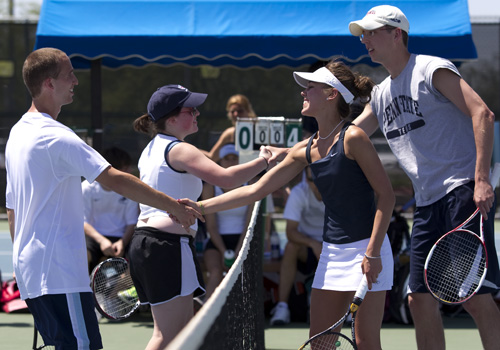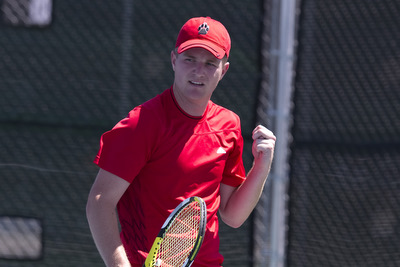> Home > Resources > Form A College Club Tennis Team On Your Campus: A Guidebook > Club Tennis 101: Steps 6-10
Back to Table of Contents
Back to Table of Contents
 |
 |
| Step 6: Elect a Governing Board | ||
|---|---|---|
| Your recreational sports director should have a structure that you can follow to set up your club tennis team’s governing board. If they do not have one available to give to you, the following is a standard structure that has been very successful in the past for numerous organizations. This structure and the duties of each position are outlined below: • President. This is the most crucial position on the governing board. The elected president will be the liaison between the club and the rec-sports department; attend all required rec-sports meetings; inform club members of policies, procedures, expectations and regulations that must be followed; familiarize incoming officers with how the board runs; submit all paperwork to the appropriate people; arrange facility reservations; oversee the club’s financial obligations; make all travel arrangements for the club (rental vehicles, hotels, contacting other club teams, etc.); lead fundraising activities; lead communication efforts within the team and between the team and other parties; and generally oversee the duties of all other board members. • Vice President. Assists the president in all duties, namely travel arrangements, scheduling, fundraising, and communication. • Treasurer. Keeps the recreational sports program staff up to date on the financial status of your club, keeps current financial records, prepares a yearly budget, initiates and ensures all club members assume responsibility for generating funds. • Secretary. Keeps accurate records of all meetings, makes sure the club’s website is up to date, leads the organization for team social events. • Committees. Using committees effectively can greatly reduce the workload of your officers. Certain activities you may want to form committees for include away trips, social events, and fundraising. Click here for a sample officers list. |
| Step 9: Plan an Event | ||
|---|---|---|
| At the beginning of the academic year planning exciting, attention-drawing events is crucial to the success of your club. Most universities have events built into their fall schedule, where different organizations can self-promote, such as freshman orientation, rec-sports day, and welcome back to school events. Use these crucual days to reach a large portion of the student body. Stage a free "Tennis On Campus Block Party" event to create excitement and interest intennis. Develop a variety of fun-filled tennis activities to generate interest in the sport and motivate sign-ups and registration for your Tennis On Campus program. Offer awards/prizes to campus organizations (dorms, fraternities, sororities, etc.) that bring the most people to the event. Once you have your team, you can continue to plan events throughout the year. Allow you and your teammates to get to know one another in a more social setting. Extra events like attending a school sporting event, bowling, team dinners, professional sporting events and more are just a few ways your team can coordinate social events. Interested in hosting your own tournament? Hosting your own successful college club tennis tournament can take plenty behind-the-scenes work; however, many club teams find hosting a tournament worth the effort. Don't be afraid to reach out to your Section Contact or local campuses in your area that have previously hosted tournaments. You can also invite the varsity tennis team and coaches to participate and help run your events. Click here to check out a blog post from Virginia Tech about managing their Virginia Tech Tournament. Don't forget to end the season off right, with a special event, such as a championship playoff, team social night, or awards banquet to highlight the triumphs and tribulations of the entire season. Create fun awards that keep the program exciting, and encourage nonparticipating students to feel comfortable about taking part in the future. |
| Step 10: Communicate Your Successes | ||
|---|---|---|
| Our Tennis On Campus teams and participants are always succeeding both on and off the court! It's important you communicate these successes to generate positive buzz for your club tennis team. Consider providing team standings and updates on a weekly or biweekly basis to generate enthusiasm and provide recognition for participants. Use the website you created to post team standings, match schedules, photos, videos, and upcoming social events. Contact the school newspaper's sports department or sportswriter and ask them to do a feature story to promote the program. One way to gain press coverage is to offer prepared press releases announcing the Tennis On Campus program's activities. Or share a team's triumph over its competitor and build anticipation and excitement surrounding an "upcoming rematch." Create e-mail blasts to keep the campus and Tennis On Campus alumni informed of results and happenings throughout the season. Be sure to e-mail any story links to Tennis On Campus so we can post them in our TOC News Section. Don't forget! If you or your club tennis team have a great story to share the Tennis On Campus National Staff would love to hear about it. We're always looking for ways to promote you and your club tennis team in both local and national media outlets (i.e. magazines, newspapers, online sources, etc.). Just take a few minutes to fill our our Club Tennis Team Media Questionnaire online and we'll do the rest! |
| Click here to continue reading: Chapter 3, Funding: Tennis On Campus Costs |
Back to Table of Contents

